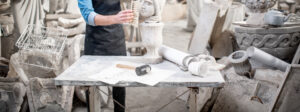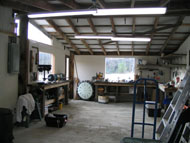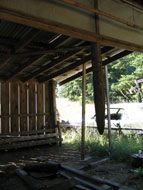
Home » Carve » Experience » Getting Started » Designing Your Sculpture Studio: Part 1 July/Aug 2004
Ed.: As you will see, Bill has a lot to say about the design and use of a sculpture studio. The Journal will be printing more of his thoughts in the next issue or two, so standby for lots and lots to think about for your present studio, or that perfect one you’ve always dreamed about.
My research for what has turned out to be this article started when I decided to build a sculpture studio. I spoke with Jeff Brash, a fellow stone sculptor on San Juan Island. He had many useful ideas, but basically said it is all about the individual’s idiosyncrasies (what size stone? For what other uses will the shop be put?) and the individual’s budget. And then I spoke with Tom Small, another local stone sculptor. “It’s all about one’s philosophy,” Tom said. So the short version of this article is this: Designing a shop depends upon your own budget, philosophy, and the uses to which your shop will be put.

I wanted more guidance on the decisions I needed to make as I thought about building a studio. Actually, Tom later fleshed out his thoughts on philosophy, and Tom and Jeff, as well as Tracy Powell and Alexandra Morosco, were happy to assist as well. I also relied heavily on advice from participants in the valuable web site www.learningstone.net (a world-wide web site of stone enthusiasts who share their knowledge). What follows is the results of my research.
I give you fair warning before you begin I have never built a sculpture studio. This predisposition to claim expertise on issues I know nothing about is not new. (After all, I’m a lawyer.) Worse, I’ve done this in print long ago, I proposed, writing for SAIL Magazine, an article on “how to buy a used boat.” Having just bought one, I knew a lot about it. The magazine wasn’t interested, but did need on article on “how to buy a new boat,” a subject about which I knew nothing. After a fair amount of research, I wrote the article, which they happily published– but without having actually bought a new boat. Subsequently, my boat broker – who was trying to sell my used boat and knew I had never purchased a new boat in my life – called to complain that one of his clients had made an offer on a new boat and included a clause the broker thought was unreasonable. When the broker said so, the client whipped out the article I had written as proof he was right. The broker knew I didn’t have a clue, but he had a hard time convincing his client of that. So be forewarned.
If I were to ask Tom Small, I think he might suggest that the time I spent drafting this article could have been more productively employed carving. He thinks too much is made of the physical space. And indeed, as you’ll see below, Tom is an advocate of the “non-studio” studio: so long as you have a roof over your head to protect you and your tools from the rain, that’s sufficient. He agrees that thought needs to be given to design, drainage, neighbors, natural light, wind conditions, electricity and water. But basically Tom’s advice is, like Nike’s: “Just Do It.” That said, this article is addressed to those who want to do it, but want to do it in a more substantial structure to hold their sculptural life.
Many beginning sculptors build a structure that seems fine in concept: For example, another lawyer-sculptor built a 14’ x 18’ building with a 6’ covered porch. Beyond that was additional outside carving space. He found the size ideal as a carving space, but forgot about his stone inventory. “Where to keep all those stones I tend to acquire,” he asked, “and where to put all the finished pieces I haven’t been able to sell yet.” So you either store elsewhere or build bigger.

Most sculptors work on more than one piece at a time. (Tom Small currently has twenty-two in various stages of completion.) So plan space for storing your in-process work, as well as your finished inventory.
You’ll also need enough space to store a lot of tools, and (if you use water inside) to protect them in cabinets or covered shelving. And for those of us who work on soft stone like alabaster, you’ll need covered storage for those stones.
Jeff Brash (who works in hard stone) suggests your workspace should be large enough to have five tools plugged in and ready for use at any one time: perhaps a diamond polishing blade, a diamond cutting blade, a diamond planer to plane large surfaces, one (or more) size variations of the tools above (like 5” and 7” cutting blades), and a die grinder. But then Jeff, by his own admission, owned 26 grinders at last count, which surely qualifies him (Jeff, please forgive me) as an “equipment whacko.”

I’d say “build as large as you can,” but you already knew that. Those in the profession full-time, typically build as large as they can afford – but because they are in the profession full-time, that often isn’t as large as they’d like. How large? Alexandra Morosco: 32 x 64, of which 16 x 32 is enclosed; Tracy Powell: 24 x 36 of which 24 x 24 is enclosed; Tom Small: 600 square feet under roof (of which none is enclosed except for a small shed for his compressor) with perhaps 1,200 feet overall in the immediate vicinity devoted to carving, some of it under pavilion-tent coverings, some just under the forest canopy.
Although Tom doesn’t have an enclosed studio, he comes from a family of builders and architects: he suggests that the minimum convenient space between walls is 16’, to allow room for shelves or workspaces at the side, and a circulation path around the sculpture in the middle.
Another sculptor (George Graham, a contributor to learningstone.net) recommends a space of 28 by 40 feet. It looked large when empty, he said, but “when I put in shelves and a work bench, a small enclosed room for granite work, a dust collector, a compressor, and space just for raw material, and finished work, it will be crowded.”
Of course, size in part is a function of cost. One issue will be the type of building you want. Post frame buildings, such as TEXMO, can get you a lot of space for the price, but will often have an industrial feel about them. But using a local contractor to stick-build a cute studio will be considerably more expensive. One compromise would be a precut stick-built building erected on site by the manufacturer’s crew.

One convenient design is a “clerestory pole barn”- that is, a raised main bay, which allows for the installation of windows on either side of the main bay, with two lower side sections. One sculptor I know uses this design with an 18’ x 24’ main bay with an 18’ rafter height; each side has a 10’ x 24’ shed bay with 12’ clearance. (TEXMO will build a shell of this basic design, with each section 12’ x 24’, for about $24,000.) For reasons of economics, many of us have to build smaller than that.
Okay, look, I’m a lawyer. So I think lawyerly-type thoughts. Such as, after a summer of stone-dust plumes drifting onto their house, how will my neighbors react? This isn’t the place for a treatise on the law of nuisance, but separate from pure legal principles, the facts are clear: if you make your neighbors’ lives miserable from your stone work, they will find a way to make your life miserable. Limiting the impact of what you do on your neighbors therefore makes sense both from a financial, as well as a neighborly, perspective. So be considerate, and at the same time, insure you are in compliance with your municipality’s zoning and noise ordinances. A call to your local government’s planning department may be useful.
We need to have enough light to see what we are doing, but not so diffuse so as to eliminate the definition that shadows add. In my querying to learningstone.net, I asked what I thought was a simple question: artists like north-facing light in their garrets. Is that true for sculptors also?
Comments were many and various. One writer (William Moore) stated that “True light reveals the truth of the sculpture we create…the subtle inconsistencies across a convexing surface reveal our limitations as workers in pursuit of perfection. The faceting from a tool chattering can only be resolved by careful study in multiple light angles at different times of day.”
As sculptors of stone, the only light we are accountable to is the light of the sun. All other light is inferior in its ability to illuminate the truth of what we leave behind. Florescent, incandescent, halogen, candle or lamp all create specific effects depending on the angle one chooses to shadow from…you must often lose contrast in one area to create shadow in another…. No matter how fluent you become in the language and application of artificial light, there are few artificial light sources which can reveal the true nature of the surface you are creating.” Tom Small also prefers to work out from under a roof, under natural light (although he said so more simply). He adds that “the way the trees filter my southern exposure is critical. There are ‘holes’ in the tree canopy that give me different lights at different times of the day, and it does affect what I work on. I enjoy that shifting with the light.”

The fantasy studio of George Graham (another learningstone.net contributor) would have sky lights, with the north and west walls (for late afternoon light) made of windows. He would rather start off with too much light and work down. He’s used shutters to block the light when necessary, preferring light coming from over his shoulder and off to the side much more then having light directly overhead, which he thinks creates distorting shadows. He prefers working outside as much as possible.
Similarly, Clive Murray-White’s view (again, a learningstone.net contributor) is that the painting tradition of favoring light from the north (or in his case, in the southern hemisphere, light from the south) doesn’t make sense to him for three-dimensional work. He chose to build his studio facing into the sun, with multiple sky lights and a large roller door for light. His reasoning: he wanted an ever-changing light source, to help him pick up weaknesses in form. (He also has a movable set of lights hanging from an overhead omni directional gantry crane, which allows him to pour light onto any area as needed.)
On the other hand, another writer to the learningstone.net site (Bill Knight) thought that: “Direct light is very undesirable and if you do build south facing skylights, you will have to deal with screening or deflecting the light…. Direct light on your work will be dazzling, but difficult to work with. Sculpting is very light dependent. “
“Vertical light is usually best. Windows are a waste of wall space and will introduce lateral light which will undermine your vertical light. I have covered all the windows in my shop. Light is the number one priority in my fantasy shop. I work by vertical daylight alone and it is very disturbing to see a piece, that I have struggled over all day, turn ghoulish and wrong when I come in at night and it is lit poorly.”
Bill Knight’s story is instructive. He moved to the country eight years ago and became the owner of a 24 by 32 foot garage-type outbuilding with a mildly pitched roof and a concrete pad, which he converted into a sculptor’s studio. Having previously had a windowless painting studio, he was excited to have the opportunity to substitute “the round glowing light of nature” for flat incandescents. So he added windows to his studio. Then he turned a whole wall into windows. Then he started cutting skylights in the roof and replaced the tin with clear polycarbonate. He liked that so much he replaced nearly the entire roof with polycarbonate. He got “wonderful splendid light-vibrating-seething!” But then he had too much light. He put a tarp over the whole thing in the hot summer and had had to hang vertical sheets of material to block the low angle raking lights of winter. He notes it is impossible to work when half the work has blinding sun on it. (Tom Small agrees that it is almost impossible to work on, or see well, the shaded part of a work when you are facing the sun: he uses a piece of plywood or a big umbrella to block the sun if he can’t rotate the work.)
Later Bill Knight discovered that light from his windows would undermine the shadow scheme from his skylights when doing exacting work. So he covered up the windows and doesn’t regret it.

His conclusion: natural light is important – either over-head florescent lights or lateral incandescents would interfere with his ability to create the natural forms he was seeking. But, he says, “the tradition of the northern skylights has a real basis in quality and workability.” So he has turned into a day-time only sculptor.
For those interested in lighting design, he recommends “A Sculptor’s Fortunes,” by Walker Hancock. Hancock wrote vividly, in his memoir, of disastrous lighting installations.
One important issue: where will the sculpture be installed? Some sculptors think each piece should be sculpted under similar lighting conditions to those where it will be viewed when installed. For example, if your sculpture will be floodlit from below at night, you will want to be sure you have studied it from that perspective first. Otherwise, I am told, the results can be bizarre. (Tom Small suggests the best solution is to make a sculpture that looks good in most light.)
Those who prefer to work in sunlight often seem to prefer diffuse sunlight broken up by shades or trees. Some sculptors find that direct light makes it difficult to distinguish between a line, and a shadow. This can be a particular problem with some types of granite local to the Northwest. Tom Small’s solution: sharp, distinct edges; definition; and graphic form. However, when you’re doing finish work like polishing, direct light can be useful.
But don’t forget when installing all those windows to get double-pane glass, for insulation. You may also want to cover your windows with lexan on the inside, to protect them from flying chips (a lesson Jeff Brash learned when a chip broke one of his windows). (ed Note: hardware cloth 1/2″ mesh also works well).
Next Installment in the series: PART 2








We need some kind of descriptive text here.